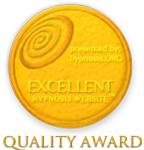
by Charles Curtis
There are hundreds of ways to practice meditation, and there is no particular organization to the field, as various groups, most of them religious in some way, have been teaching meditation for thousands of years, so the literature is crowded by books written by gurus who associate their particular way of doing meditation with a particular religious sect.
While much of the religious meditation literature comes from Eastern sources, such as Buddhism, there are Western traditions, such as Contemplative Meditation practiced in various forms of mystical Christianity.
MINDFULNESS MEDITATION
Looking at Eastern meditation in particular, the Buddhist tradition has a way of doing meditation called “mindfulness” meditation which is simply being aware (mindful) of life without having to change it. This is used as a way of gaining insight into life, and certain mindfulness practices are therefore called “insight meditation”.
This approach to meditation is of interest to hypnotists, as there has been a movement gaining momentum for several years to incorporate a secular form of mindfulness meditation into the mental health professions. The impetus for this was initiated almost 30 years ago by Jon Kabat-Zinn with his Mindfulness-Based-Stress-Reduction (MBSR) program at the University of Massachusetts medical school. Originally focusing on pain management, the program has now shown that any form of stress can be reduced by this protocol.
In particular, this program has been spectacularly successful in showing that the peaceful insightful state fostered by mindfulness has tangible medical benefits which measurably reduce medical costs for the patient with long-term chronic illness.
THE DIFFERENCE BETWEEN HYPNOSIS AND MEDITATION
Within the mindfulness field, there are several varieties of practice. One type is guided mindfulness meditation (which is, for all intents and purposes, direct suggestion hypnosis by another name). In this form of mindfulness meditation, while participants focus on their subjective experience with their eyes closed, a group leader uses a few words or sentences to suggest an image (“the mountain”) or theme (“becoming distant from life’s problems”) or activity (“a bodyscan”).
The most noticeable difference between guided mindfulness meditation and traditional hypnosis is that there are large gaps of silence in the mindfulness meditation. That is, the leader gives a suggestion and then there may be a pause of up to several minutes while that suggestion is experienced in the mind of the listener, before the leader speaks again. In other words, most of the meditation is silence.
Having extensive experience with both traditional hypnosis and guided mindfulness (both as a participant and a group leader), I find much to like about the mindfulness approach. Since guided mindfulness group participants typically experience profound peacefulness by the end of the meditation, it becomes obvious that the group leader does not have to be continuously talking to achieve a profoundly useful result.
Since hypnotists are trained to “keep the patter going”, this is a definite difference in philosophy. If the participant can achieve a peaceful state without the hypnotist’s mouth continuously in motion, then the hypnotist can give himself a break by talking less, in fact, much less. In fact, the group leader talks so much less during guided mindfulness meditation that the hypnotist giving this approach a try for the first time might feel insecure, afraid he is losing the participant’s interest.
What he doesn’t realize is that the participant’s mind is resting peacefully, and in fact, the participant can easily go deeper without a continuous stream of words because the meditator is, by definition, already self-absorbed and focusing on internal experience. Because there is so much less stimulation from the voice of the leader than a standard hypnosis script it is in fact possible to go quite deep relatively quickly. So the achievement of amnesiac somnambulism or the coma state are both common in meditators who have gone deep.
CHANGING EXPERIENCE BY NOT TRYING TO CHANGE IT
A difference between meditation and hypnosis is that the meditator is not trying to change his experience. So if he is a medical client experiencing chronic physical pain, at first he is mindful of his physical pain, and so his discomfort may, temporarily, increase.
However, eventually, he will, (as NLPers say), “go meta”, he will “step back from” his experience of pain, and the pain will recede into the distance. And since much medical pain is the result of muscle spasms, such as around an injury site, as the relaxed physical state of deep meditation kicks in, the now more relaxed muscles are no longer painful, so that source of pain simply disappears.
Consequently, mindfulness meditation has shown much efficacy for pain control. Kabat-Zinn’s MBSR program has been doing outcome studies for years, consistently showing significant pain reduction in the participants. As mindfulness has gained in popularity, these studies have now been replicated by other mindfulness researchers.
ADDING SUGGESTION TO MEDITATION
Mindfulness meditation teachers are not trained in the subtleties of post-hypnotic suggestion. However, once the meditation students are deep enough, there will be critical factor bypass, so the words spoken by the teachers will have the power of hypnotic suggestion.
Here the hypnotist trained in pain control has an advantage. He can not only utilize the mindfulness approach to help the pain client “go meta” on his pain, he also knows how to use judiciously applied direct suggestion to deepen the pain control effect.
LEARNING MEDITATION AS A SKILL
From a medical point of view, a reason to teach the client to do mindfulness meditation is that the client is learning a skill by practicing an experience monitored during a group training program that extends over several weeks. Therefore, the client, once trained, is not reliant on the group leader for pain control but can replicate the experience on his own. (This is made easier by distributing training CDs which contain the sparse patter of the mindfulness meditation leader and which can be used at home during the training period).
The hypnotic equivalent would be teaching the client self-hypnosis. However, self-hypnosis is an active technique , as the client has to do something with his mind. Mindfulness meditation, in contrast, is a passive technique, and many patients find the passive technique of mindfulness (simply being aware without having to do anything) to be easier to both learn and practice.
The downside of using a passive technique is that it typically takes a meditation student much longer to learn meditation. Meditation trainings are 8 weeks in length to accommodate this more lengthy training period.
BEHIND THE WATERFALL
Once the participant has learned meditation, he is trained to “stand behind the waterfall” of life. In so doing, he learns to become separate from the pain of his life experience.
This is a shift into a non-judgmental state of mind which brings peace. It incorporates the physiological shift of the “relaxation response ” (Herbert Benson), which is a movement from sympathetic nervous system over-stimulation to parasympathetic nervous system rest and regeneration.
TANGIBLE BENEFITS
This is not just a theoretical ideal. One of the results emerging from the meditation field is a research database showing that achieving this meta state has material health benefits.
In the January 2011 issue of “Shambala Sun”, a magazine celebrating all things meditative, especially in the context of Buddhism, several articles summarize the results of recent scientific studies on the results of the practice of mindfulness meditation.
For example, Ford Motor Company was spending 80-90 million dollars a year managing back pain suffered by its employees. Since employees taking a prescription opiate for back pain cannot work on an assembly line, they must go on disability, so this represents an ongoing financial drain. It turned out that $2,300 of the price of each Ford vehicle went for health care costs, and $400 of this went for back pain alone.
Use of prescription opiates went down 60% in employees participating in a mindfulness-meditation based pain management program. That these employees were also able to go back to work represents real bottom line dollars in an American auto company that in a down economy is searching for every penny that can be saved.
REVERSING HEART DISEASE AND OTHER HEALTH CONDITIONS
Dean Ornish MD has been prescribing meditation for his heart patients for many years, and early on proved that heart disease can be reversed through meditation and lifestyle changes. A more recent study shows that these effects can have major consequences – a study involving 8 hospitals showed that 80% of the candidates for angioplasty or bypass could forego the operation if meditation were learned instead. At an average of $30,000 per patient ($99,000 for bypass), that’s a HUGE savings in money, not to mention a great reduction in suffering.
Other studies quoted in this issue of the magazine show HUGE reductions in one medical condition after another: 42% less irritable bowel syndrome, 75% less binge eating, 50% less substance abuse, noticeable improvements in coping with multiple sclerosis, and a dramatic shift in major depression relapse (62% reduced to 36%).
WHY IS THIS USEFUL INFORMATION
-
Because mindfulness is essentially a specialized form of hypnosis, everything that applies to mindfulness meditation applies to hypnosis. All the studies that show mindfulness to be efficacious are proof that hypnosis works. So as the increase in interest in mindfulness leads to more and more mindfulness studies, this will lead to more and more evidence that these relaxed states of mind, which you already know how to produce in your clients, have measurably positive benefits. And doctors and other professionals will listen when you quote these statistics as evidence of the efficacy of mind/body stress-reduction techniques.
-
The medical and mental health fields are excited about mindfulness meditation and its possibilities. They need to learn how to do it, they need experienced instructors to show them the ins and outs, and they need places to send their clients. Once you learn the ins and outs of mindfulness meditation and how it is practiced in these professions (which you can do in 8 weeks using either of the sources below), you are perfectly positioned to instruct medical professionals and/or to lead mindfulness groups yourself.






